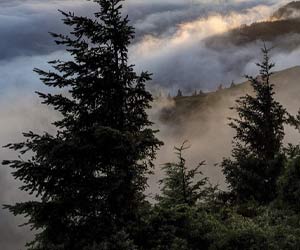My First Summer in the Sierra (Classic, Nature, Penguin)
Select Format
Select Condition 
Book Overview
In the summer of 1869, John Muir, a young Scottish immigrant, joined a crew of shepherds in the foothills of California's Sierra Nevada Mountains. The diary he kept while tending sheep formed the... This description may be from another edition of this product.
Format:Paperback
Language:English
ISBN:0140255702
ISBN13:9780140255706
Release Date:March 1987
Publisher:Penguin Publishing Group
Length:336 Pages
Weight:0.54 lbs.
Dimensions:0.7" x 5.1" x 7.8"
Related Subjects
Biographical Biographies Biographies & History Biography & History Nature Nature & Ecology TravelCustomer Reviews
6 ratings
An amazing introduction to John Muir
Published by Thriftbooks.com User , 7 years ago
Nature is the only gardener able to do work so fine
Published by Thriftbooks.com User , 17 years ago
Gretel Ehrlich provides the introduction. It is noted that John Muir walked first, wrote later. In 1868 he was thirty years old and had walked a thousand miles. He was a seeker in self-exile such as D.H. Lawrence, Rockwell Kent, and Basho. Muir chronicles a rite of passage. The summer described began in June, 1869. Forty-one years later the account was pieced together. Muir worked for Mr. Delaney as a sheepherder. He had a St. Bernard dog as a companion. Mr. Delaney encouraged Muir to sketch and pursue his naturalist studies. He was to learn that sheep cannot be governed when hungry. Bushes are stripped. The sheep resemble locusts in their destructive potential. Two kinds of squirrels are evident, the Douglas and the California Gray. The wood rat is more like a squirrel than a rat. He bulds large striking looking houses. Sheep camp bread is baked in Dutch ovens. Descriptions of silver firs, Sierra juniper, yellow and sugar pines, Douglas spruce, sequoia, hemlock, and dwarf pines appear in the account of the summer. Nature is extravagant. The group follows the Yosemite trail. Mules flee from bears, and dogs want to. Bears are very shy. Indian patience is required to see them. Making sheep cross a stream is a challenge. Once one goes in, the others push in pell-mell. Lake Tenaya was named for one of the chiefs of the Yosemite tribe. Sierra mosquitoes are nearly an inch long. Sierra chipmunks are arboreal and squirrel-like. Grouse and woodpeckers are abundant in the vicinity of Mount Hoffman. On August third Muir found Professor Butler, his teacher at the University of Wisconsin, because, sensing his presence, John Muir made inquiries at the only hotel in the area and was directed to go to the Vernal Falls. Professor Butler and his party were astonished that John Muir found them. In times of hunger the dogs, men, and sheep are confronted with lions, leopards, wolves, hyenas, and panthers. The names of places are exciting and descriptive--Moraine Lake, Mono Desert, Soda Springs, Unicorn Peak, Cathedral Range, Tuolumne, Hetch-Hetchy Valley. Muir's self-directed studies in botany clearly account for some of the strengths of this nature narrative. In the end Mr. Delaney tells Muir he will be famous some day.The author describes himself as an incredible wilderness lover. September twenty second ended Muir's first excursion. The book is a marvel. Sketches and photographs are included and enhance the work.
Discovering the Range of Light
Published by Thriftbooks.com User , 18 years ago
John Muir was born in 1838 and at a young age emigrated from Scotland with his family to a Wisconsin farm. He escaped the hard labor of the farm and his father's backward Biblical obsessions by displaying great powers of visualization. From principles learned from books, he whittled and fashioned barometers, thermometers, clocks and other marvels from the barest of materials. But he repudiated his inventive genius, which could have made him rich, after an industrial accident left him temporarily blinded; and he took off for the wilderness to discover plants and the natural world. This book is a journal account of Muir's finding a place for himself in Yosemite after some dangerous wandering through the hazards of reconstruction in the South after the Civil War. It's a book of discovery. Although flocks of sheep like Muir's employer's were allowed to overrun backcountry meadows, and gold miners had ripped apart the lower river beds, the Sierras then were still a place that had many aspects that had not yet been explored or understood. The backcountry was much more vulnerable to exploitation (though in many ways less endangered) than today, but there was freer and unfettered access for one who sought out it's mysteries and wanted to learn. This book shows Muir's powers of visualization in his beginning to formulate the role that glaciers play in the formation of the landscape. No one at that time had come to a solid understanding of what had made Yosemite Valley. And, although it might seem quite clear in retrospect, it took a strong mind of one who up until that time had been adrift in the world, a wanderer who studied plants, to visualize his theories and make them known to the world. Anyone who has not experienced the Sierra first hand cannot really appreciate this book. There are lengthy and numerous descriptions of plants and animals, loving descriptions in Muir's fashion, that can only be understood by one who has reveled in the same places and likewise wants to examine all the details. It's not a purely intellectual appreciation. It's something felt with the whole body, with all the senses alive. Muir always writes of being drawn into Nature, of never turning back, as in the case of his foolhardy venture to the brink of Yosemite Falls, "I therefore concluded not to venture farther, but did nevertheless". There's also this kind of breathless anticipation of tomorrow- if only I will be given a chance to explore its fountains...
A classic of outdoor literature
Published by Thriftbooks.com User , 18 years ago
'First Summer in the Sierra' is a classic among nature classics. A must read. Eloquent and accessible.
A classic of outdoor literature
Published by Thriftbooks.com User , 18 years ago
'First Summer in the Sierra' is a classic among nature classics. This is a John Muirs' story about his formative time in the Sierras, detailing his experiences, his feelings and observations about spending months surrounded by nature and beauty. It is very inspirational, eloquent and accessible.
Exuberant. "In full communion with everything good."
Published by Thriftbooks.com User , 19 years ago
This is the third of Muir's books that I have read, the first in several years. Gretel Ehrlich writes in her introduction: "[Muir] wrote: 'I should like to live here always. It is so calm and withdrawn while open to the universe in full communion with everything good.' And in so speaking of the place he loved best, described himself." In the inimitable way of John Muir, the book is essentially a journal, in this case of his thoughts and travels in the Sierra Nevada Mountains in the summer of 1869. On one day (July 15) he tells of his great desire to look directly down the thousands of vertical feet of Yosemite Falls leading him into a death-defying pilgrimage onto shear rock: "If I was to get down to the brink at all that rough edge, which might offer slight finger-holds, was the only way. But the slope . . . looked dangerously smooth and steep, and the swift roaring flood beneath, overhead, and beside me was very nerve-trying. I therefore concluded not to venture farther, but did nevertheless." I'll guess that Muir is the only person to have ever positioned himself on the lip of this great waterfall. Having earlier read of his mountaineering and storm-reveling experiences, even this is not quite surprising. On another day he writes of encountering a brown bear, a housefly, and a grasshopper, and treats them all as being equally fascinating. In a later entry, Muir contemplates raindrops with these words: "How far they have to go, how many cups to fill, great and small, cells too small to be seen, cups holding half a drop as well as lake basins between the hills, each replenished with equal care, every drop in all the blessed throng a silvery newborn star with lake and river, garden and grove, valley and mountain, all that the landscape holds reflected in its crystal depths, God's messenger, angel of love sent on its way with majesty and pomp and display of power that make man's greatest shows ridiculous. Now the storm is over, the sky is clear, the last rolling thunder-wave is spent on the peaks, and where are the raindrops now -- what has become of all the shining throng? In winged vapor rising some are already hastening back to the sky, some have gone into the plants, creeping through invisible doors into the round rooms of cells, some are locked in crystals of ice, some in rock crystals, some in porous moraines to keep their small springs flowing, some have gone journeying on in the rivers to join the larger raindrop of the ocean. From form to form, beauty to beauty, ever changing, never resting, all are speeded on with love's enthusiasm, singing with the stars the eternal song of creation." For Muir, the mostly self-educated botanist and geologist, nothing Nature does is anything less than miraculous. Only in our finest moments of insight, revelation if you will, do we see the world as Muir saw it always. [July 12, 1869] "We saw another party of Yosemite tourists to-day. Somehow most of these travelers seem to care but little for the glorio
My First Summer in the Sierra Mentions in Our Blog

Fixation Friday: Outdoor Adventures
Published by Ashly Moore Sheldon • November 30, 2023
What is Fixation Friday? In this new blog series, we'll spotlight a trending topic to explore. This week, it's Outdoor Adventures. If this is something you're excited about, read on as we follow the paths (and trails) this theme leads us down.

Celebrating Edward Abbey
Published by Ashly Moore Sheldon • January 31, 2020
In celebration of Edward Abbey's birthday earlier this week, we are featuring a reading list of similar authors who came before and after him. More than just environmentalists, these activists raised clarion calls in defense of nature.






